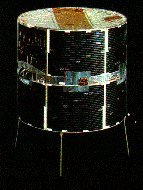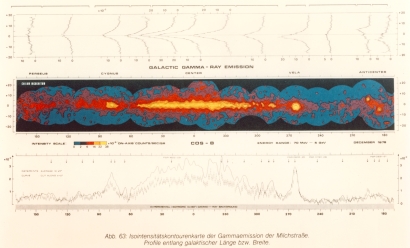Summary
Its scientific mission was to study in detail the sources of extra-terrestrial gamma radiation at energies above about 30 MeV.
 |
|
COS-B satellite |
The principal objectives were to study the spectrum and distribution of galactic gamma- rays, investigate the flux and distribution of extragalactic gamma-ray emission, investigate some known point sources in the gamma-ray range and search for new point sources.
The major results were the creation of the 2CG Catalogue that contained about 25 gamma-ray sources out of 30 observations made during the first three years. A binary system, Cygnus X-3 containing a pulsar and a gamma-ray emitter was thoroughly studied by COS-B. Two other enhanced objects, for which a lightcurve was compiled were the Crab and Vela sources. Furthermore, a first full gamma-ray map of the Galactic plane was made and the first gamma-ray AGN (active galactic nucleus) 3C 273 was detected. And finally, the spectrum of Geminga, one of the brightest gamma-ray sources in the compiled catalogue was derived to locate it to within 0.25 degrees permitting counterpart searches.
 |
|
Galactic gamma-ray emission |
The originally foreseen duration of the mission was two years, but in fact Cos-B was finally switched off on 25 April 1982, having functioned successfully for 6 years and 8 months.
During this time an extensive survey of the Galaxy was made in the energy range 50 MeV to 5 GeV.